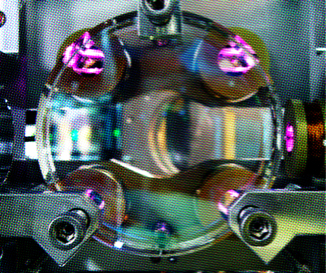
重力波研究交流会
GW research exchange meeting
次回以降の重力波研究交流会
Upcoming GW-REMs
The 102nd REM: someday in September 2019, Friday
- Time: 13:00-14:00
- Speaker: TBD
- Title: TBD
The 101st REM: August 9th, 2019, Friday
- Time: 13:00-14:00
- Location: JAXA Sagamihara campus
- Speaker: Morio Toyoshima (NICT)
Title: "Recent Trends of Space Laser Communications"
- Information for Zoom remote connection
- Meeting URL: TBA
- password: ask the organizers
The 100th REM: July 12th, 2019, Friday
- Time: 13:00-14:00
- Speaker: Shoichi Oshino (ICRR, the University of Tokyo)
Title: "A review on BBH formations in N-body simulations (tentative)"
- Zoom connection information
Meeting URL: https://zoom.us/j/5045179604
- password: ask the organizers
The 99th REM: June 14th, 2019, Friday
- Time: 13:00-14:00
- Speaker: Hisaaki Shinkai (Osaka Inst. Tech.)
Title: "INO: Interplanetary Network of Optical Lattice Clocks"
ref: Int. J. Mod. Phys. D. (2019) https://doi.org/10.1142/S0218271819400029 or arXiv:1809.10317
he new technique of measuring frequency by optical lattice clocks now approaches to the relative precision of (\Delta f/f)=O(10^{-18}). We propose to place such precise clocks in space and to use Doppler tracking method for detecting low-frequency gravitational wave below 1 Hz. Our idea is to locate three satellites at one A.U. distance (say at L1, L4 & L5 of the Sun-Earth orbit), and apply the Doppler tracking method by communicating ``the time" each other. Applying the current available technologies, we obtain the sensitivity for gravitational wave with three or four-order improvement (h_{n}\sim 10^{-17} or 10^{-18} level in 10^{-5} Hz -- 1 Hz) than that of Cassini satellite in 2001. This sensitivity enables us to observe black-hole mergers of their mass greater than 10^5 M_\odot in the cosmological scale. Based on the hierarchical growth model of black-holes in galaxies, we estimate the event rate of detection will be 20-50 a year. We nickname "INO" (Interplanetary Network of Optical Lattice Clocks) for this system, named after Tadataka Ino (1745--1818), a Japanese astronomer, cartographer, and geodesist.
P.S.
I also introduce the latest results of measurement of gravitational potential using optical lattice clock at Tokyo Sky Tree, the difference of 450m height, if the results will come to me. - Zoom connection information
Meeting URL: https://zoom.us/j/5045179604
- password: ask the organizers
The past GW REM talks
The 98th REM: May 17th, 2019, Friday
- Time: 13:00-14:00
- Speaker: Federico Paoletti and Irene Fiori (European Gravitational Observatory)
Title: "Virgo environmental status"
- Zoom connection information
Meeting URL: https://zoom.us/j/5045179604
- password: ask the organizers
The 97th REM: May/10th/2019, Fri.
- Time: 13:00-14:00
- Speaker: Tomohiro Yamada (ICRR, University of Tokyo)
Title: "Searching solutions to achieve high-Q sapphire blade in Rome"
- Zoom connection information
Meeting URL: https://zoom.us/j/5045179604
- password: ask the organizers
The 96th REM: Apr./5th/2019, Fri.
- Time: 13:00-14:00
- Location: Room 604, Science Building 1, the University of Tokyo
- Speaker: Nobuyuki Matsumoto (Tohoku University)
Title: "Table-top experiments for fundamental physics based on technology of gravitational-wave detectors"
- Zoom connection information
Meeting URL: https://zoom.us/j/5045179604
- password: ask the organizers
The 95th REM: Mar./22nd/2019, Fri.
- Time: 13:00-14:00
- Location: KAGRA analysis building@Kamioka
- Speaker: Lucia Trozzo (ICRR, the University of Tokyo)
Title: "Advanced Virgo suspension control"
- Abstract:
In this talk I will give you an overview of the control strategy adopted on the AdV seismic isolation system (the Superattenuator). I will show you the impact of this strategy on the residual motion of the test masses and the AdV sensitivity curve in the region below 10 Hz at the time of first triple detection of GW.
- Zoom connection information
Meeting URL: https://zoom.us/j/5045179604
- password: ask the organizers
The 94th REM: Feb./22nd/2019, Fri.
- Location: NAOJ (tentative)
- Time: 13:00-14:00
- Speaker: Satoshi Tanioka (NAOJ)
- "Noise In The Mirror"
https://gwdoc.icrr.u-tokyo.ac.jp/cgi-bin/private/DocDB/ShowDocument?docid=9861
- Zoom connection information
Meeting URL: https://zoom.us/j/5045179604
- password: ask the organizers or see the invitation email
93rd REM: June/15/2018, Fri.
- Time: 17:00-19:00
- Talk 1: Julia Casanueva (INFN - Sezione di Pisa)
- 「Lock Acquisition in Advanced Virgo (part 1): Guided Lock, Frequency stabilization and Automatic Alignment」
- Talk 2:Diego Bersanetti (I.N.F.N. - Sezione di Genova)
「Lock Acquisition in Advanced Virgo (part 2): DC Readout, Noise Subtraction & Automation」
- Zoom connection information
Meeting URL: https://zoom.us/j/8678936825
- password: ask the organizers or see the invitation email
92nd REM June/1/2018, Fri.
- Time: 10:00-11:00
- Talk: Andrew Matas (University of Minnesota)「Searches for the stochastic gravitational wave background in Advanced LIGO's first observing run」
- Zoom connection
Meeting URL: https://zoom.us/j/8678936825
- password: ask the organizers or see the invitation email
91st Dec./8/2017, Fri.
- Location: online with eZuce
- Time: 13:00-14:00
Talk:仏坂健太(Kenta Hotokezaka) (Princeton University)「A neutron star merger GW170817 and its EM counterparts」
- eZuce connection information
- Title: JGW seminar
- Community: KEK Community
Password:n/a
- Meeting Access Information:
SeeVoghRN Application http://srn.ezuce.com/joinSRN?meeting=M9MIMi222eD2Di9298DD99
Mobile App : Meeting ID: 781 4378 or Link: http://srn.ezuce.com/join?meeting=M9MIMi222eD2Di9298DD99
90the Oct./20/2017, Fri.
- Location: web meeting through eZuce
- Time: 13:00-14:00
- Talk:宮本晃伸 (Nobuaki, Miyamoto)(大阪市立大学; Osaka City Univ.)「重力波観測によるPopIII星の存在の間接的証明方法の研究」
- eZuce connection information
Title:Monthly JGW seminar
- Community: KEK Community
Password:n/a
- Meeting Access Information:
SeeVoghRN Application http://srn.ezuce.com/joinSRN?meeting=MMMeMn2D2tDsDs9a9sD29M
Mobile App : Meeting ID: 779 0427 or Link: http://srn.ezuce.com/join?meeting=MMMeMn2D2tDsDs9a9sD29M
Archives for the past talks
- The archives from earlier years are written in Japanese (it is a history!).
Useful links
How to receive the announcements
 One has to subscribe to the mailing list called gw_comm in order to receive our announcement emails. Please ask one of our organizers for subscription.
One has to subscribe to the mailing list called gw_comm in order to receive our announcement emails. Please ask one of our organizers for subscription. The organizers can be found in this page.
